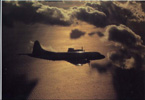FatR
Posts: 2522
Joined: 10/23/2009
From: St.Petersburg, Russia
Status: offline

|
quote:
ORIGINAL: Sardaukar
"Flying Cigar" changed quickly to "Flying Cigarette Lighter"...for obvious reasons.
US medium bombers flew regularly unescorted missions against for example Rabaul, even when there was large amount of fighters operating from there. Of course they preferred escort, but could and did fly attack missions against defended Japanese bases with reasonable loss rates. Heavy bombers like B-17 and B-24 did that even more. This is at least what "Fire in the Sky" says.
On what page? Because, somehow, it was necessary to put fighter airfield within short range of Rabaul to attack it successfully, as sending unescorted bombers at altitudes was way too costly (night bombings and high-altitude raids allowed survival, but rarely allowed doing real harm). This goes both for medium and heavy bombers. And in fact Fire in the Sky explicitly mentions, on p. 648, that until January 1944 (when attrition began to tell), attacks on Rabaul were supposed to include two fighters per bomber.
quote:
ORIGINAL: Sardaukar
Betty was created as "Super Nell", to be able to assist IJN Kido Butai carrier force in "decisive battle" and was thus given extraordinary range. Tradeoff, of course, with tragic consequences to IJN bomber crews. Also, it's range was so high that it outranged Zero. This made it's outstanding range quite useless, since Betty did not have much chance to survive against fighter defense. They would have been better off having comparable range with Zero and use more armour, self-sealing tanks and better defensive armament. As it was, Betty (and Nell) was horribly vulnerable to fighters and AA.
And yet, its survival rate somehow was generally great for the first half of 1942, and pretty decent even later, except in the conditions I outlined above. Until Allied air superiority became overwhelming, anyway. Defensive armament of Betties was pretty heavy for most of its times (up to 4x20mm by late war), although improvements often were slow to appear in mass production, and I don't see how Japanese could possibly improve it, without magically improving their weapon industry. As about the range, Betties needed it, because IJN could not allow special searchplanes, at least not in adequate numbers. I'm not informed enough to tell, whether some of it was really extraneous. Betty construction was very durable and the only real (although major) vulnerability was fuel tanks. Their main problem was in the fact that Japanese command too often sent them to missions where no WW II bomber could have fared well (at least with the numbers Japanese had in RL).
quote:
ORIGINAL: Sardaukar
There are good quotes in "Fire in the Sky" from Japanese IJNAF officers, how B-17 and B-24 caused unsolved problem to IJNAF in Rabaul. they just did not have right tools to counter heavy bomber formations, especially with fighter escort.
Fire in the Sky does not provide much Japanese viewpoint, and I don't remember these quotes, so, please, page numbers again? And anyway, the main problem Japanese were unable to solve is called "Allied numerical superiority". Fire in the Sky tends to gloss over it. But, you know, the biggest Betty airfield attack in South Pacific consisted of 44 planes, while formations of 60+ bombers (with 200 or more sorties per day overall) were standard for major Allied raids by second half of 1943.
quote:
ORIGINAL: Sardaukar
And Rabaul was probably best defended IJN/IJA base in aerial sense..and it was where IJN land based forces virtually ceased to be viable fighting force in late 1943.
In February 1944. And the real deathblow was the destruction of Truk, which not only stripped Rabaul of new planes to maintain the battle of attrition, but also made defending it essentially meaningless.
< Message edited by FatR -- 12/3/2009 5:07:33 PM >
|
 Printable Version
Printable Version












 New Messages
New Messages No New Messages
No New Messages Hot Topic w/ New Messages
Hot Topic w/ New Messages Hot Topic w/o New Messages
Hot Topic w/o New Messages Locked w/ New Messages
Locked w/ New Messages Locked w/o New Messages
Locked w/o New Messages Post New Thread
Post New Thread